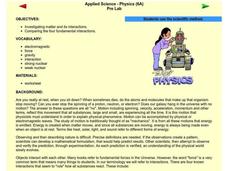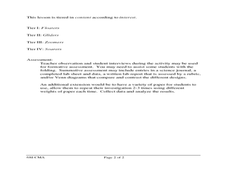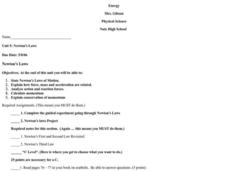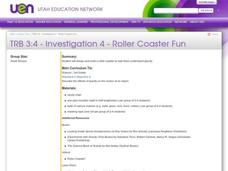Cornell University
Alka-Seltzer Rockets
Blast off! An engaging hands-on activity has pupils create rockets powered by Alka-Seltzer. They learn about the physics behind these rockets throughout the process.
Teach Engineering
Android Acceleration
Prepare to accelerate your Android. Pupils prep for the upcoming activity in this third installment of a four-part series. The lesson progresses nicely by first introducing different types of acceleration to the class. The teacher...
Polytechnic Institute of NYU
Potential vs. Kinetic Energy
Legos in science class? Watch your pupils fall in love with this activity. After learning to measure potential and kinetic energy, young scientists create their own ramps using Lego Mindstorm sensors and software.
LABScI
Catapult: Flight of the Marshmallows
Watch your marshmallows fly. The engaging STEM activity has groups create a catapult to launch marshmallows. After testing their prototypes, they consider improvements and redesign their catapults.
Workforce Solutions
Newton's Laws
Two lessons explore the connection between energy transformation and a given job. In lesson one, small groups role-play a scenario that showcases the energy transformations that may take place during a job-specific task. The second...
STEM for Teachers
Tsunami!
How does the depth of an ocean affect the speed of a tsunami's waves? Use Jell-o, graham crackers, and marshmallows to model the effects of an underwater earthquake and its resulting tsunami. The instructional activity includes hands-on...
Curated OER
Matter and Energy
Students explore energy by completing a science worksheet in class. For this principles of matter lesson, students define the vocabulary terms force, gravity, nuclear, and electromagnetic before reading assigned text about energy....
Curated OER
Vectors
Students describe motion by the use of adding vectors to obtain the resultant vector. They comprehend the meaning of a resultant vector. Students identify the difference between the x and y components of vector quantities. Students...
Curated OER
Testing and Refining Aircraft Design
Young scholars design and make a flying device. They work in small groups to brainstorm ideas for the design of their device. They choose an idea or combination of ideas to use for their design and create a sketch of their design. The...
Curated OER
A Classical & Relativistic Trip to a Black Hole
High schoolers calculate distance, velocity, acceleration and time on their fantasy trip to the black hold. They apply Newton's Laws of Motion and calculate circular motion. They discuss any questions that may arise.
Curated OER
Origami Flight: The Physical Setting
Sixth graders investigate the forces that move certain objects. In this physics lesson, 6th graders design and create paper flying objects using origami methods, which they practice flying in different conditions. Students...
Curated OER
Mr. and Miss Big Feet
Third graders experiment with gravitational force. In this physical science lesson plan, 3rd graders send matchbox cars off a ramp while changing the amount of weight attached to the car. Students record their data and discuss the results.
Curated OER
Introduction to Friction
Students study the properties of the frictional force between two surfaces in contact. They inspect various phenomena in nature where friction plays an important role and demonstrate
Curated OER
Balloon Rockets
Students, after reviewing and analyzing Newton's third law of motion, make balloon rockets and experiment with a variety of models. After the experiment, they chart the results and form conclusions. In addition, they compare/contrast...
Curated OER
Simple Machine Research
Fifth graders demonstrate the ability to use scientific skills and Processes to describe forces that act upon objects to cause specific changes in motion. They identify and describe a science problem related to forces and simple machines.
Curated OER
Simple Machines V - Wheels and Axles and Gears
Fourth graders investigate the principles and uses of gears, and examine how gears can be used to alter the direction of motion or the speed of an object. They observe two cars with different sized wheels roll down an inclined plane,...
Curated OER
Newton's Laws
Students state Newton's Laws of Motion. They explain how force, mass and acceleration are related. They analyze action and reaction forces, calculate momentum,
and explain conservation of momentum
Curated OER
Roller Coaster Fun
Third graders review the effects of gravity on how objects move. In groups, they design a roller coaster and share it with their classmates. Using materials given to them, they build their roller coaster and let a ball roll on the...
Curated OER
What a Drag
Students learn examples of friction and drag, and suggest ways to reduce the impact of these forces. The equation that governs common frictional forces is introduced, and during a hands-on activity, students experimentally measure a...
Curated OER
Simple Machines
Fourth graders discover the principles and uses of gears noting that they can be used to change the direction of motion or the speed of an object. They may also change the force and/or distance through which an object turns. They then...
Curated OER
Race the Track! Design Challenge
Students use the design process to investigate physical science. For this force and motion lesson, design a track to achieve a specified outcome. Students complete additional experiments with speed and distance. Students...
Curated OER
Crash Test Physics
Learners design and test balsa cars. In this crash tet instructional activity, students design and build their own cars to specifications. They explore the physics of motion and vehicle crash safety.
Curated OER
Incline Planes
Students determine the forces necessary to move a truck on an inclined plane with weight and slope as variables. They identify the cheapest way to transport trash to local garbage disposal sites.
Curated OER
Deducing Induction
Students examine how changing magnetic fields induce currents in
loops and coils, determine orientation and magnitude of magnetic field,
describe Michael Faraday's experiments that led to conclusion that changing
magnetic force induces...























